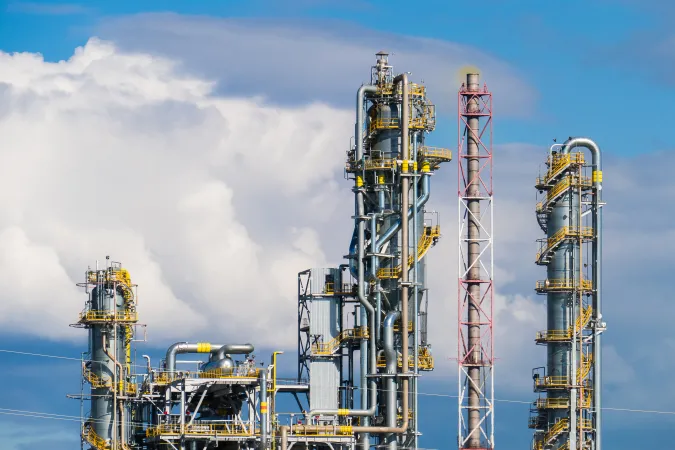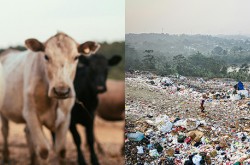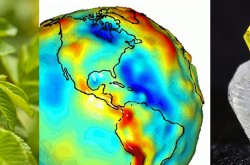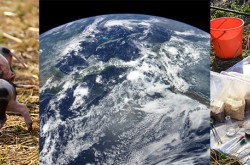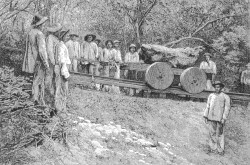From plant to pantry: Tracking pollution in Canada's food production
In his first article, “Opening a digital window on our way of life,” guest author Tim Lougheed introduced us to the federal government’s National Pollutant Release Inventory (NPRI). In this second piece, Lougheed illustrates how NPRI data can be used to learn about the pollutants created through food production.
When we think about the accomplishments that represent our civilization, does the modern grocery store come to mind? It should. Even the most modest one offers nutritional riches unrivalled in human history. Our ancestors, who for countless millennia hunted and searched to find enough to eat, would be astonished to watch us casually stroll through a place containing aisle after aisle of nutritional possibilities. Yet for us, it is merely routine to select from shelves loaded to capacity with all manner of food, as if by magic.[1]
Yet there is nothing magical here, only a dazzlingly complex, massive multinational production network. Synthetic fertilizers and nutritionally optimized animal feeds enable farmers around the world to raise record volumes of produce and livestock that can travel vast distances to converge on your local store. Along the way are all kinds of stops: from government inspection centres that check fruits and vegetables for safety, to factory-scale facilities that turn flour, sugar, and other ingredients into your favourite cookie, then package it for delivery.
Not surprisingly, these vast and varied activities affect our environment.[2] The substances and methods used in growing, transporting, and processing food leave their mark on land, water, and air. Given the size of this enterprise, which feeds millions of Canadians and billions more people beyond our borders, this impact warrants close monitoring.
The federal government does this through its National Pollutant Release Inventory (NPRI), which tracks the emissions of certain pollutants to land, water and air from thousands of facilities across the country, including those that produce the food we eat. Its database, which covers the last 26 years, is available to the public at canada.ca/npri. You can search it to find out about, for example, the types of pollution released in your region, the facilities that emit the pollutants that the government tracks, or changes to the amounts and locations of this pollution across the country.
Your own query could start with, for example, the cooking oil in your kitchen cupboard. If it’s canola or soy, it likely originated on the Canadian prairies, where oilseeds are a major crop and an export worth billions of dollars annually.[3] But cooking oil is just one oilseed product. Sunflower and camelina seeds can be turned into biofuels. Flax is incorporated into food and also into industrial products: paint, wood composites, and more.[4]
Extraction of edible oil starts with mechanical pressing. Next, food-grade solvents extract leftover oil from the pressed seeds (those solvents are then recovered by distillation and other means and re-used). Finally, the oil is refined through physical and chemical processes to remove impurities, which improves taste and shelf-life.
The main solvent in this process is n-Hexane. As used in the food industry, it poses no health risk. But it is one of the chemicals we call volatile organic compounds (VOCs), which tend to evaporate into the atmosphere and can harm humans at high enough concentrations.[5] VOCs are tracked, since a large amount released to the air could be hazardous. N-Hexane emissions can escape from processing plants during its transfer and storage, through leaks in piping and vents, as well as in vapours during the refining process (crude vegetable oil contains very small quantities of dissolved n-Hexane). The concentration of VOCs released to the air varies across the country and this interests people researching the environmental effects of oilseed processing in different regions.
The NPRI enables you to do just that: follow the pollution trends related to an activity such as oilseed processing. A query about VOCs, for example, reveals that since 2009, these emissions have declined in Canada by more than 12%. In figure 1, the data reveals some geographic nuances within that decline. Alberta’s VOC output has actually risen, mainly because they had two major oilseed processing plants in 2009 and three as of 2017. Output also rose in Quebec, which got its first plant after 2009.

Figure 1. VOC emissions from oilseed processing in Alberta, Manitoba, Ontario, Quebec and Saskatchewan, in 2009 (left) versus 2017 (right)
A different story emerges from NPRI information about another kind of pollution from oilseed processing: particulate matter. These are the aerosol particles from industrial exhausts, such as smokestacks. Figure 2 shows that this form of pollution increased by 71% between 2009 and 2017. You’ll notice that this graph doesn’t resemble figure 1, nor is the geographic distribution the same. This is because particulate matter and VOCs are different kinds of pollution. The particulate matter is likely generated by combustion — from engines running the equipment that transports and grinds the oilseeds. The VOCs, on the other hand, are carried in the evaporation from the processing plants.

Figure 2. Particulate matter emissions from oilseed processing in Alberta, Manitoba, Ontario, Quebec and Saskatchewan, in 2009 (left) versus 2017 (right)
Let’s continue to consider the implications of that bottle of cooking oil. How about the fertilizer that nurtured the oilseed crop? Different fertilizers come from different sources. Nitrogen fertilizer, one of the most important inputs in crop production, is manufactured chemically by combining nitrogen from the air with the hydrogen in natural gas to form ammonia. Potassium and phosphorus, on the other hand, are minerals physically extracted by mining, then chemically separated from the rock they were part of.
Fertilizer production is an important part of Canada’s agricultural sector, as well as another source of pollution that Canada tracks and controls. And, once again, the NPRI can help you learn about its effects on the environment
At industrial scales, the process of creating nitrogen fertilizer consumes large amounts of energy and releases carbon dioxide (CO2) and carbon monoxide (CO) into the air. The NPRI shows us that releases of CO have increased by around 47% since 2009. Figure 3 shows that this increase was especially pronounced in Alberta: it has more plants involved in the CO-producing part of fertilizer manufacturing than all the other producing provinces combined.

Figure 3. Carbon monoxide (CO) emissions from fertilizer production in Alberta, Manitoba, Ontario and Saskatchewan, in 2009 (left) versus 2017 (right)
In contrast, figure 4 shows that particulate matter from fertilizer production dropped by almost 54% during those years. In fertilizer production, this form of pollution probably comes from the mechanical equipment in the production facilities, and there are now fewer of these facilities across Canada.

Figure 4. Particulate matter emissions from fertilizer production in Alberta, Manitoba, Ontario and Saskatchewan, in 2009 (left) versus 2017 (right)
Stemming from your initial curiosity about a kitchen staple, the NPRI may give you insight into the relationship between pollution and one type of agriculture activity. The database can also bring to light the trends that change these pollution patterns: a plant’s operations may vary year to year as companies control costs, comply with environmental regulations, or respond to market demand for their products.
While the data shown here can’t tell you everything that is happening, it can inspire you to find out more about pollution, including how it’s evolving in your part of the country.
But here’s what’s most important: because the NPRI’s pollution tracking activity operates as openly and publicly as possible, you can rest assured that it is being managed responsibly.
[1] “The Surprising Way a Supermarket Changed the World,” Time, 9 September 2016
http://time.com/4480303/supermarkets-history/
“How The A&P Changed The Way We Shop,” NPR, 23 August 2011
https://www.npr.org/2011/08/23/139761274/how-the-a-p-changed-the-way-we-shop
[2] “Environmental Cost of Shipping Groceries Around the World,” The New York Times, 26 April 2008
https://www.nytimes.com/2008/04/26/business/worldbusiness/26food.html
[3] Canadian Oilseed Processors Association, “Overview of Canada’s Oilseed Processing Sector,” October 2018, https://copacanada.com/industry-profile/
[4] Flax Council of Canada, “Flax Usage,” https://flaxcouncil.ca/flax-usage/
[5] Canadian Council of Ministers of the Environment, Canadian Soil Quality Guidelines for the Protection of Environmental and Human Health (2011), http://ceqg-rcqe.ccme.ca/download/en/336



